Railroad adventure IX: Soft sleeper Shanghai - Beijing
To get back from Hangzhou and Shanghai to Beijing, I had gotten tickets for a night train. There are no classes on Chinese trains, since China is a communist and thus egalitarian country. On the other hand, one may buy tickets for a soft sleeper or a hard sleeper. People without sufficient political training might take those for first and second class, but this is not what they are.
The compartment was very comfortable, new and fresh, with an individual regulator for the heat, a television screen that offered six different films on DVD (most in Chinese only, though). And the train made good speed. 1454 kilometers in 9 hours and 54 minutes. The maximum speed I noticed was 246 km/h.


The compartment was very comfortable, new and fresh, with an individual regulator for the heat, a television screen that offered six different films on DVD (most in Chinese only, though). And the train made good speed. 1454 kilometers in 9 hours and 54 minutes. The maximum speed I noticed was 246 km/h.


Railroad adventure VIII: The world's fastest train on ordinary rails
On Sunday, we took the train from Hangzhou to Shanghai. The 169 kilometer trip took no more than 45 minutes, after the train had reached its top speed of 349 km/h. I never caught a photo of that, but close enough. The train was comfortable and arrived exactly on time.


The train was spotlessly clean both on the inside and the outside. Not surprising considering that as soon as we had stopped in Shanghai, a band of cleaners started to clean the outside (but only on the right side of the train).



The train was spotlessly clean both on the inside and the outside. Not surprising considering that as soon as we had stopped in Shanghai, a band of cleaners started to clean the outside (but only on the right side of the train).

Railroad adventure VI: Taiwan High Speed Rail
My blogging has suffered from all the work of finishing my book, on which I also spent much of my free time in Japan. So I have many things still to say about what I have been doing in the last few weeks, which have included trips for lecturing to Taiwan and Japan.
In Taiwan, I had the pleasure of experiencing the Taiwanese bullet train. Very pleasant.

The rail line was of course very straight. To take this photo, I stepped over the yellow line. Immediately, a guard blew his whistle and signed for me to step back behind it. I had of course checked carefully that there was no train anywhere close to where we were.

The train eventually arrived. Exactly on time, of course!

We made up to 290 km/h, but I have picture evidence only for 287. You'll just have to trust me for the last 3 kms! Despite the speed, the train ran more smoothely than the small train between Ludvika and Västerås, and of course much, much faster. Actually, I think this was much smoother than SJ's vaunted X2000 express train. The Swedish government is cutting funding for track maintenance, apparently wishing to go down the same drain as the USA both for communications and for highschool education (where Sweden is already almost there).

The happy travellers on the way back from the conference, together with our gracious Taiwanese minders.
In Taiwan, I had the pleasure of experiencing the Taiwanese bullet train. Very pleasant.

The rail line was of course very straight. To take this photo, I stepped over the yellow line. Immediately, a guard blew his whistle and signed for me to step back behind it. I had of course checked carefully that there was no train anywhere close to where we were.

The train eventually arrived. Exactly on time, of course!

We made up to 290 km/h, but I have picture evidence only for 287. You'll just have to trust me for the last 3 kms! Despite the speed, the train ran more smoothely than the small train between Ludvika and Västerås, and of course much, much faster. Actually, I think this was much smoother than SJ's vaunted X2000 express train. The Swedish government is cutting funding for track maintenance, apparently wishing to go down the same drain as the USA both for communications and for highschool education (where Sweden is already almost there).

The happy travellers on the way back from the conference, together with our gracious Taiwanese minders.
Railroad adventure VII: Shinkansen Tokyo-Niigata
Shinkansen means "new main line." The trains are also known in English as "bullet train". The tracks are very straight, and the trains go up to 300 km/h. There were, unfortunately, no announcements of the speed on the trains I took, so I do not know how fast we travelled. We got from Tokyo to Niigata in quite exactly 2 hours, and the ride was very comfortable in cars with two levels.
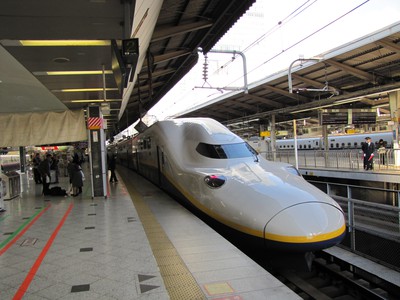

Railroad adventure V: Datong - Beijing Bei via Badaling
Going back from Datong to Beijing Bei (North), the train took a different route than on the outward trip. This route is very exciting since it goes very close to the Great Wall, and also features steep gradients (over 3 percent) and a switch-back).
We'll start at the Datong railway station, a monumental building. The letters on top say Da Tong zhan (station).
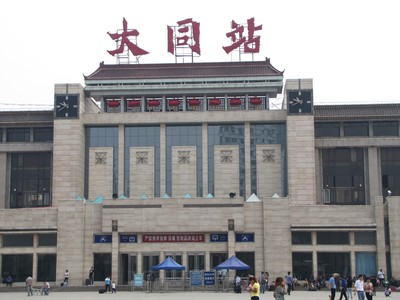
At first I thought that there was a huge line to get into the station, and I was happy to discover, though, that the lines were not to get into the station. Chinese railway tickets are sold a certain number of days in advance, and clearly these people were waiting to buy tickets to desirable destinations. I believe the large electronic board announces how many tickets are left for various destinations and in various classes. The Chinese railway system is underdimensioned for the demand, but China is building a lot of new railroads (again throwing light on my earlier comments about the endowed chair in railroad engineering which Yale has made into a general civil engineering chair).

The first part of the trip was uneventful. I covered this distance before, and the windows were even dirtier this time, making it hard to get good pictures. I did see a few interesting things that I did not see on the outward journey, such as this town with a city wall. I do not know its name, but I shall try to find out.

Chinese sheep.

Wind power.

Each car has its own attendent, and I was fascinated and impressed by how conscientious the attendents were. The one in my car was very careful that all the luggage on the luggage racks was correctly placed, with no straps hanging down. He often had to climb a seat to reach, but he always used a piece of textile to climb on. (I would be good as a car attendent, for I am able to reach the overhead spaces without climbing the seats!). When he was not doing anything in particular, he still sat and watched over the car from his own little compartment at the end.
A funny detail was when the tickets where checked. Then the attendant came first and shouted "Tickets up" (I think I recognized these words). Then three conductors came and quickly punched everyone's ticket. No "thank yous" or other small talk, just a very efficient operation.
Note, this is a hard seat car (second class). Still airconditioned, and very clean. In fact the attendant was constantly cleaning the floors. I had to lift my feet five times in seven hours to allow him to sweep or mop the floor!

When we had a longer stop, the attendant in the soft seat-car (first class) even polished the sign indicating the origin and destination of the train.

That sign, after being polished. The train ran from Huhehaote (Hohhot) in Inner Mongolia to Tongliao (also in Inner Mongolia). This is a trip of 1478 kilometers that it makes in 25 hours and 15 minutes.
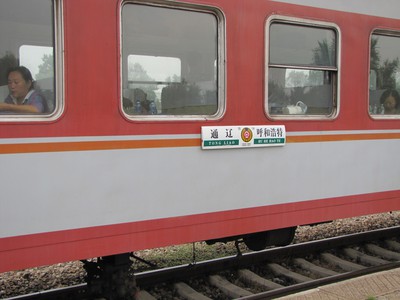
By the way, the train was five minutes late from Datong, but we still arrived two minutes early in Beijing.
Soon after Xuanhua, where we changed engines from an electric to a diesel, the tracks we followed diverged from those that I had followed on the outward journey. There was now single track, with wooden sleepers, and no longer any electric overhead wire and no continuously welded tracks (clickety-clack!). We were getting in on the old line from Beijing to the northwest, to so-called Jingzhang railway. It was built between 1905 and 1909 (when China was still ruled by the imperial dynasty of Qing).
The train stopped for over 20 minutes in Kangzhuang in order to attach a help engine to the end of the train. We were going to be going downhill at steep gradients down to the plain around Beijing, and the train must have needed the extra breaking power.
The train ride between Kanzhuang and Nankou (where the help engine was removed) is spectacular. Not only is the natural scenery magnificent. The track goes in a narrow gorge with high and steep mountains on both sides, but it also gets very close to the Great Wall of China. This is the most famous section of the wall, the one closest to Beijing, and thus the one most visited by tourists. I got many pictures of the wall. Sadly, the dirty windows and the ever denser fog conspired to make the image quality rather poor. Here are, at any rate, some of the best.

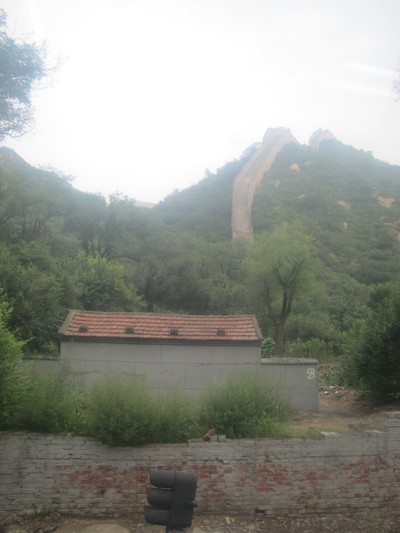


Just after Badaling station (where we did not stop), the train passed through a tunnel, which must have been about 2 kilometers long. Just after the tunnel we arrived at Qinglongqiao station where there is a switchback. The train stops on the station, then changes direction to go down a different track after the switch have been changed. In this way a very steep gradient can be avoided. The railway does still have a very steep gradient, up to 33 pro mille (greater than on the Gotthardbahn, see Adventure II). So we stopped, and reversed. Then the train went very slowly and carefully downhill.
In the picture one sees the lower of the two rails, photographed from the train which is still on the upper rail.

The Jingzhang railway is the first railway in China to be financed, engineered and built by native Chinese. The engineer in charge was 詹天佑, Jeme Tien Yow (1861-1919; with modern pinyin transliteration his name would be Zhan Tianyou). Jeme graduate from Yale College in 1881 with a degree in civil engineering with specialization in railway engineering! (I hope you can see why I still wonder why Yale got rid of our endowed chair in railway engineering!). He was buried at the switchback, where his statue also stands (on his grave?).

A photograph of him, borrowed from Wikipedia.
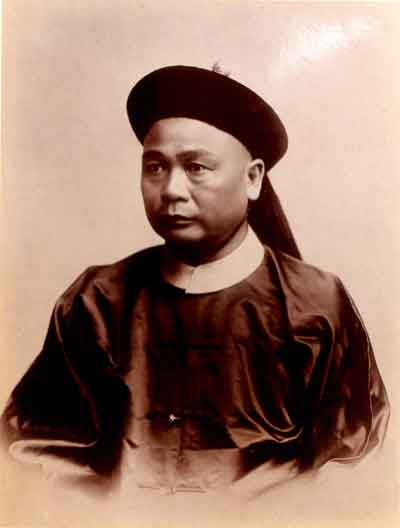
There were several switchbacks in Sweden. One of them was on the narrow-gauge Hörken-Fredriksberg-Neva railroad, and the switch was at Lövsjön, which is about 50 kilometers from Ludvika, today in the middle of nowhere. I visited the site together with my father and my children last month! Alas, I did not have my camera with me then, but I found a recent photo on a webpage.

We'll start at the Datong railway station, a monumental building. The letters on top say Da Tong zhan (station).

At first I thought that there was a huge line to get into the station, and I was happy to discover, though, that the lines were not to get into the station. Chinese railway tickets are sold a certain number of days in advance, and clearly these people were waiting to buy tickets to desirable destinations. I believe the large electronic board announces how many tickets are left for various destinations and in various classes. The Chinese railway system is underdimensioned for the demand, but China is building a lot of new railroads (again throwing light on my earlier comments about the endowed chair in railroad engineering which Yale has made into a general civil engineering chair).

The first part of the trip was uneventful. I covered this distance before, and the windows were even dirtier this time, making it hard to get good pictures. I did see a few interesting things that I did not see on the outward journey, such as this town with a city wall. I do not know its name, but I shall try to find out.

Chinese sheep.

Wind power.

Each car has its own attendent, and I was fascinated and impressed by how conscientious the attendents were. The one in my car was very careful that all the luggage on the luggage racks was correctly placed, with no straps hanging down. He often had to climb a seat to reach, but he always used a piece of textile to climb on. (I would be good as a car attendent, for I am able to reach the overhead spaces without climbing the seats!). When he was not doing anything in particular, he still sat and watched over the car from his own little compartment at the end.
A funny detail was when the tickets where checked. Then the attendant came first and shouted "Tickets up" (I think I recognized these words). Then three conductors came and quickly punched everyone's ticket. No "thank yous" or other small talk, just a very efficient operation.
Note, this is a hard seat car (second class). Still airconditioned, and very clean. In fact the attendant was constantly cleaning the floors. I had to lift my feet five times in seven hours to allow him to sweep or mop the floor!

When we had a longer stop, the attendant in the soft seat-car (first class) even polished the sign indicating the origin and destination of the train.

That sign, after being polished. The train ran from Huhehaote (Hohhot) in Inner Mongolia to Tongliao (also in Inner Mongolia). This is a trip of 1478 kilometers that it makes in 25 hours and 15 minutes.

By the way, the train was five minutes late from Datong, but we still arrived two minutes early in Beijing.
Soon after Xuanhua, where we changed engines from an electric to a diesel, the tracks we followed diverged from those that I had followed on the outward journey. There was now single track, with wooden sleepers, and no longer any electric overhead wire and no continuously welded tracks (clickety-clack!). We were getting in on the old line from Beijing to the northwest, to so-called Jingzhang railway. It was built between 1905 and 1909 (when China was still ruled by the imperial dynasty of Qing).
The train stopped for over 20 minutes in Kangzhuang in order to attach a help engine to the end of the train. We were going to be going downhill at steep gradients down to the plain around Beijing, and the train must have needed the extra breaking power.
The train ride between Kanzhuang and Nankou (where the help engine was removed) is spectacular. Not only is the natural scenery magnificent. The track goes in a narrow gorge with high and steep mountains on both sides, but it also gets very close to the Great Wall of China. This is the most famous section of the wall, the one closest to Beijing, and thus the one most visited by tourists. I got many pictures of the wall. Sadly, the dirty windows and the ever denser fog conspired to make the image quality rather poor. Here are, at any rate, some of the best.




Just after Badaling station (where we did not stop), the train passed through a tunnel, which must have been about 2 kilometers long. Just after the tunnel we arrived at Qinglongqiao station where there is a switchback. The train stops on the station, then changes direction to go down a different track after the switch have been changed. In this way a very steep gradient can be avoided. The railway does still have a very steep gradient, up to 33 pro mille (greater than on the Gotthardbahn, see Adventure II). So we stopped, and reversed. Then the train went very slowly and carefully downhill.
In the picture one sees the lower of the two rails, photographed from the train which is still on the upper rail.

The Jingzhang railway is the first railway in China to be financed, engineered and built by native Chinese. The engineer in charge was 詹天佑, Jeme Tien Yow (1861-1919; with modern pinyin transliteration his name would be Zhan Tianyou). Jeme graduate from Yale College in 1881 with a degree in civil engineering with specialization in railway engineering! (I hope you can see why I still wonder why Yale got rid of our endowed chair in railway engineering!). He was buried at the switchback, where his statue also stands (on his grave?).

A photograph of him, borrowed from Wikipedia.

There were several switchbacks in Sweden. One of them was on the narrow-gauge Hörken-Fredriksberg-Neva railroad, and the switch was at Lövsjön, which is about 50 kilometers from Ludvika, today in the middle of nowhere. I visited the site together with my father and my children last month! Alas, I did not have my camera with me then, but I found a recent photo on a webpage.

Railroad adventure IV: Beijing Xi - Datong
Datong is an old city in Shanxi province with a lot of remnants from what in the West would be the Middle Ages, including a preserved city wall, Buddhist monasteries, the oldest remaining dragon wall in china, and more. So I got a train from Beijing Xi (West) train station to Datong. The trip took a little more than six hours, and there was some amazing scenery outside the windows, including views of the Great Wall.
I started out from Beijing Xi. The always wonderful Ningping accompanied me there in a taxi and guided me so that I would get to the right place.

I thought the station in Basel was big and crowded. This one was enormous in comparison. I took the photo at a moment when it was not so crowded.

The picture above is from the main concourse. On the sides of it were (12, I think) different waiting rooms. A big sign directed travellers to a specific waiting room depending on which train one wanted. Then there was a special waiting room for "mothers with children" (!) and disabled people. Since I am greatly disabled in my knowledge of Chinese, I was allowed to wait there (people in that room get to board the train first).

When we first arrived, my train's number was displayed in red, which means that it was delayed. It did not say for how long, and a special sign said (in Chinese; Ningping interpreted) that they were trying to find out how late is was going to be. When I realized that the train had started out from Nancheng in Southern China at 11 a.m. the day before (and was supposed to leave from Beijing at 9.36, I despaired and expected it to be many hours late. Just as I was considering whether I would be able to change my ticket for a later train that might leave earlier did a time pop up for my train.
As you all can see, the sign tells us that the 1483 to Baotou (which is in Inner Mongolia) would leave at 10.12.
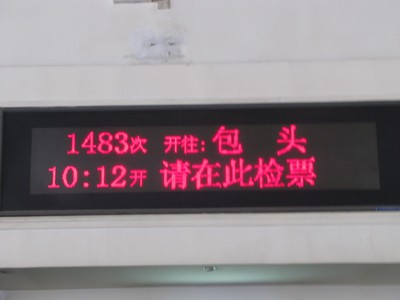
The train arrived, and I got onboard to the space that was mine, with kind help from the railway personell. The train (no. 1482/1483) runs Nanchang-Baotou, which is a distance of 2398 kilometers, and which according to the time table takes 35 hours and 4 minutes. I was only on it for a little more than 6 hours.


The train was enormous and absolutely packed. I never saw the end of it. I was in car 12, I walked to car 15-16 before turning around, not even then being sure where the end was. It must have had more than twenty cars. It started and ran very smoothely (Chinese railroads maintains their tracks, even out in the boondogs, considerably better than do American railway companies). Only when the train broke was there ever a jilt. I guess the train does not have the most modern braking pads. The fact that the train number does not have letter in front of it, means that it is an old, "traditional" train that stops often.

Most of the train are cars with couchettes (Sw. "liggvagn"), and I had one of those. The berths were comfortable, and - miraculously - not shorten than I. I even took a nap. But most of the time, I was at the window taking in the view and snapping photos.

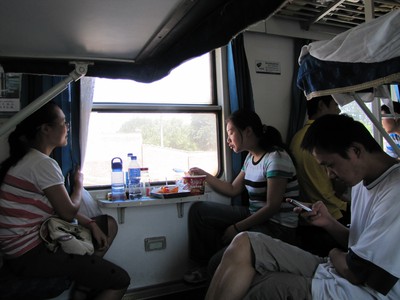
So some view from the windows, dirtier than the Swiss windows, but I have a better camera now, so the pictures came through. Soon after leaving Beijing Xi did we meet a freight train, which was turning off to another route. It was very long, probably some 40 cars, and I think it was headed by two engines (much like the trains of iron ore from Blötberget to Domnarvet in my childhood, for which we often waited forever at the crossing on the way from Ludvika to our home outside town). China transports very much of its internal freight by train. A very good idea.

A clear sign of industrializing China: high-voltage tranfer lines, heavy work in a dry riverbed, and a provisional (?) bridge over it.
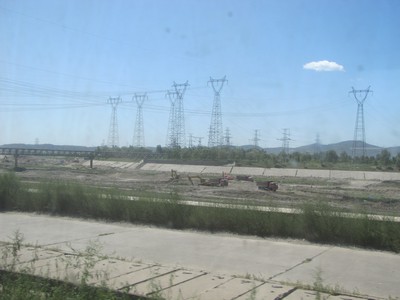
Our track was joined by a track coming from the side on a slender bridge. A single track only, but I guess that they are building a second bridgs on those pillars in the foreground.

We approached the mountain range that I think is called the Western Hills. Soon we were going up the mountains, which produced many astonishing sights. Some of the best were visible so briefly that I had no chance of photographing them. There were very many tunnels (can I guess 30-40), some of them very long, several kilometers.
The route we took is a short cut built, I think, in the 1950s to supplement the original route which I believe I shall take back to Beijing.

The train windows now produced wonder upon wonder.





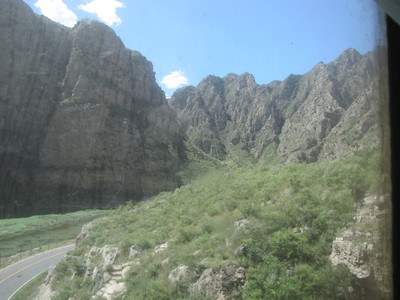



The track went parallel to the Great Wall. but at some distance, for several kilometers around Yanggao. Sometimes one could easily see it.
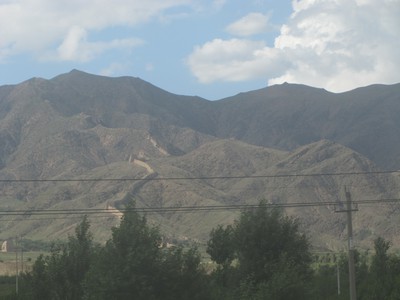

I made friends on the train. My closest neighbor in the bunks was this woman from Baotou, who also took the photo of me that follows.


I "spoke" with several others, too, a young couple who were on the second tier in my compartment, a man from Inner Mongolia with wonderful Mongolian facial features (but he did not want to be photographed), and two school girls, who were the only ones who spoke some English. One of the girls was reading The Da Vinci Code in Chinese! She told me that she likes the book.
I am certain that I was the only European on the train, and people were obviously curious. I broke the ice by asking in Chinese the young man where the toilet is. When I came back, a man asked me from where I came. As I answered, there were happy Chinese faces poking out from all tiers of the bunks, following the conversation (such as it was; we had severe problems understanding each other). When I left, everyone said goodbye, zaijian!
OK, so I mentioned the toilet. I am sure you are all curious about what it was like. It was cleaner than some toilets I have seen on SJ trains (Swedish rail company).

But the style was standard squatting, Asian-style.

I started out from Beijing Xi. The always wonderful Ningping accompanied me there in a taxi and guided me so that I would get to the right place.

I thought the station in Basel was big and crowded. This one was enormous in comparison. I took the photo at a moment when it was not so crowded.

The picture above is from the main concourse. On the sides of it were (12, I think) different waiting rooms. A big sign directed travellers to a specific waiting room depending on which train one wanted. Then there was a special waiting room for "mothers with children" (!) and disabled people. Since I am greatly disabled in my knowledge of Chinese, I was allowed to wait there (people in that room get to board the train first).

When we first arrived, my train's number was displayed in red, which means that it was delayed. It did not say for how long, and a special sign said (in Chinese; Ningping interpreted) that they were trying to find out how late is was going to be. When I realized that the train had started out from Nancheng in Southern China at 11 a.m. the day before (and was supposed to leave from Beijing at 9.36, I despaired and expected it to be many hours late. Just as I was considering whether I would be able to change my ticket for a later train that might leave earlier did a time pop up for my train.
As you all can see, the sign tells us that the 1483 to Baotou (which is in Inner Mongolia) would leave at 10.12.

The train arrived, and I got onboard to the space that was mine, with kind help from the railway personell. The train (no. 1482/1483) runs Nanchang-Baotou, which is a distance of 2398 kilometers, and which according to the time table takes 35 hours and 4 minutes. I was only on it for a little more than 6 hours.


The train was enormous and absolutely packed. I never saw the end of it. I was in car 12, I walked to car 15-16 before turning around, not even then being sure where the end was. It must have had more than twenty cars. It started and ran very smoothely (Chinese railroads maintains their tracks, even out in the boondogs, considerably better than do American railway companies). Only when the train broke was there ever a jilt. I guess the train does not have the most modern braking pads. The fact that the train number does not have letter in front of it, means that it is an old, "traditional" train that stops often.

Most of the train are cars with couchettes (Sw. "liggvagn"), and I had one of those. The berths were comfortable, and - miraculously - not shorten than I. I even took a nap. But most of the time, I was at the window taking in the view and snapping photos.


So some view from the windows, dirtier than the Swiss windows, but I have a better camera now, so the pictures came through. Soon after leaving Beijing Xi did we meet a freight train, which was turning off to another route. It was very long, probably some 40 cars, and I think it was headed by two engines (much like the trains of iron ore from Blötberget to Domnarvet in my childhood, for which we often waited forever at the crossing on the way from Ludvika to our home outside town). China transports very much of its internal freight by train. A very good idea.

A clear sign of industrializing China: high-voltage tranfer lines, heavy work in a dry riverbed, and a provisional (?) bridge over it.

Our track was joined by a track coming from the side on a slender bridge. A single track only, but I guess that they are building a second bridgs on those pillars in the foreground.

We approached the mountain range that I think is called the Western Hills. Soon we were going up the mountains, which produced many astonishing sights. Some of the best were visible so briefly that I had no chance of photographing them. There were very many tunnels (can I guess 30-40), some of them very long, several kilometers.
The route we took is a short cut built, I think, in the 1950s to supplement the original route which I believe I shall take back to Beijing.

The train windows now produced wonder upon wonder.









The track went parallel to the Great Wall. but at some distance, for several kilometers around Yanggao. Sometimes one could easily see it.


I made friends on the train. My closest neighbor in the bunks was this woman from Baotou, who also took the photo of me that follows.


I "spoke" with several others, too, a young couple who were on the second tier in my compartment, a man from Inner Mongolia with wonderful Mongolian facial features (but he did not want to be photographed), and two school girls, who were the only ones who spoke some English. One of the girls was reading The Da Vinci Code in Chinese! She told me that she likes the book.
I am certain that I was the only European on the train, and people were obviously curious. I broke the ice by asking in Chinese the young man where the toilet is. When I came back, a man asked me from where I came. As I answered, there were happy Chinese faces poking out from all tiers of the bunks, following the conversation (such as it was; we had severe problems understanding each other). When I left, everyone said goodbye, zaijian!
OK, so I mentioned the toilet. I am sure you are all curious about what it was like. It was cleaner than some toilets I have seen on SJ trains (Swedish rail company).

But the style was standard squatting, Asian-style.

Railroad adventure III: Stockholm - Karlstad - Ludvika - Stockholm
Det här hände egentligen före Railroad adventure II, men det var väl kanske inte så noga med numreringen.
Elsa och jag hade en vecka själva, medan Hjalmar var hemma hos sin mamma och gick i skolan. Så vi åkte tåg till Karlstad för att lyssna på ett föredrag om Värmlands runstenar. Sedan for vi till Ludvika för att träffa farfar och ha roligt i badhuset där. Vi bodde i min lilla lägenhet.
Fantastiskt med direkttåg en gång om dagen från Karlstad till Ludvika (via Kristinehamn, Nykroppa, Ställdalen, Grängesberg)! Tack Värmlandstrafik!

En van resenär på Stockholms Central.
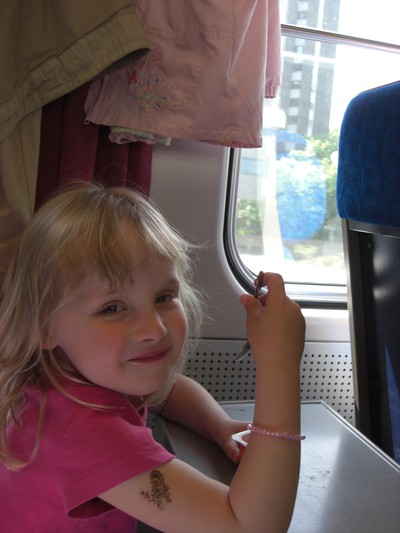
Bekvämt att äta yoghurt på tåget.

Alltid roliga saker att titta på utanför fönstret!

Och man kan också fotografera pappa.
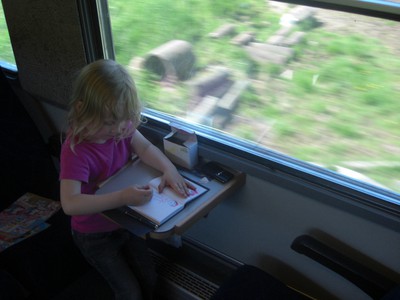
Och både Elsa och pappa tycker om att Elsa ritar fina bilder i pappas anteckningsbok.
Från Ludvika till Stockholm åker man två tåg. Först Tåg i Bergslagen till Västerås, sedan SJ till Stockholm. I Västerås visade det sig att SJ var en timme försenat, så vi gick till MacDonalds och åt litet lunch. Sedan kom tåget, det var överfullt. Elsa fick sitta i mitt knä, så att vi kunde göra plats åt en 87-årig dam att sitta. Det var het och trångt. Och så en massa signalfel och så, att vi stod stilla i flera minuter flera gånger. Och när vi kom till Spånga stannade tåget helt och hållet. Det hade varit en dödsolycka vid Tomteboda (de håller på att bygga en ny järnvägslinje genom, eller snarare under eftersom den går i tunnel!) Stockholm, och en av arbetarna hade blivit påkörd av ett tåg. Så det var helt stopp i tågtrafiken. Tråkigt, eftersom vi skulle träffa Jessica, Claes, Roger och andra på Mälarpaviljongen. Jag försökte ringa efter en taxi, men det var naturligtvis inte att tänka på. Till slut tog vi helt enkelt bussen till Solna Centrum och sedan till farmor i Bergshamra.
En trevlig koda: jag klagade till SJ och fick tillbaks halva priset av tågbiljetten! Trodde inte det skulle gå så bra och smidigt som det faktiskt gjorde.
Elsa och jag hade en vecka själva, medan Hjalmar var hemma hos sin mamma och gick i skolan. Så vi åkte tåg till Karlstad för att lyssna på ett föredrag om Värmlands runstenar. Sedan for vi till Ludvika för att träffa farfar och ha roligt i badhuset där. Vi bodde i min lilla lägenhet.
Fantastiskt med direkttåg en gång om dagen från Karlstad till Ludvika (via Kristinehamn, Nykroppa, Ställdalen, Grängesberg)! Tack Värmlandstrafik!

En van resenär på Stockholms Central.

Bekvämt att äta yoghurt på tåget.

Alltid roliga saker att titta på utanför fönstret!

Och man kan också fotografera pappa.

Och både Elsa och pappa tycker om att Elsa ritar fina bilder i pappas anteckningsbok.
Från Ludvika till Stockholm åker man två tåg. Först Tåg i Bergslagen till Västerås, sedan SJ till Stockholm. I Västerås visade det sig att SJ var en timme försenat, så vi gick till MacDonalds och åt litet lunch. Sedan kom tåget, det var överfullt. Elsa fick sitta i mitt knä, så att vi kunde göra plats åt en 87-årig dam att sitta. Det var het och trångt. Och så en massa signalfel och så, att vi stod stilla i flera minuter flera gånger. Och när vi kom till Spånga stannade tåget helt och hållet. Det hade varit en dödsolycka vid Tomteboda (de håller på att bygga en ny järnvägslinje genom, eller snarare under eftersom den går i tunnel!) Stockholm, och en av arbetarna hade blivit påkörd av ett tåg. Så det var helt stopp i tågtrafiken. Tråkigt, eftersom vi skulle träffa Jessica, Claes, Roger och andra på Mälarpaviljongen. Jag försökte ringa efter en taxi, men det var naturligtvis inte att tänka på. Till slut tog vi helt enkelt bussen till Solna Centrum och sedan till farmor i Bergshamra.
En trevlig koda: jag klagade till SJ och fick tillbaks halva priset av tågbiljetten! Trodde inte det skulle gå så bra och smidigt som det faktiskt gjorde.
Railroad adventure IIb: Stockholm - Basel
The distance Stockholm - Basel was of course longer than the Gotthardbahn, if rather less scenic, but still a part of my Railroad adventure II. I traveled the distance in only two trains, an X 2000 from Stockholm to Copenhagen, and then a CityNightLine sleeping car Copenhagen - Basel. (Some of the images are from the trip south, some from the trip north.)


Basel SBB station was pleasant.
The night train between Copenhagen and Basel was very comfortable. I had a private second-class compartment, slept like a log, was served breakfast at my seat, and even had a shower on the way back (the shower was broken on the way south).

The train stopped at Padborg on the German-Danish border to change engines. It was nice to be able to take a long walk on the platform along the entire train, which was now quite long with new cars coming from Munich and Amsterdam having been added to over the night. The sleeping cars are in two storeys. My second-class compartment was downstairs. It still was about 2 meters in height.
I loved the little compartment which felt like a great luxury, but was not ridiculously expensive. Hard, if not impossible to fotograph. But I was very comfortable in it.



A great big window through which to look at what passed outside, while one could work inside.

And then the attendant came and made up the bed when I wanted to sleep!
Dirty windows, alas, especially on the train going north, but I got some images.

Crossing the Rhine.



Two pictures from the old bridge over the Lilla Bält, between Fyn and Jutland. One can see the new autobridge over the straits on one of them.

Approaching the Stora Bält sound between Fyn and Själland. This is the bridge for cars, the train goes in a long tunnel under the water. Signs everywhere in the train proclaim that this is the safest stretch of railroad in Denmark. That makes me worry about the rest of the trip, if the railroads there are not as safe.

Roskilde.

The train at the Hovedbangården in Copenhagen.

The bridge over the Sound (Öresund), between Själland and Skåne, or between Denmark and Sweden.

We end where we started: the train that took me from Stockholm to Copenhagen is coming in to the platform in Stockholm. It is strange, but of all the trains I took on these two 26-hour journeys, it was the Swedish leg that was most uncomfortable with hot cars packed full of more or less noisy passengers. I was suprised, for I really like the X2000-trains (the express trains that lean in the curves).
Finally, the last picture is dedicated to one of my dearest friends. He is missed even in Basel.



Basel SBB station was pleasant.
The night train between Copenhagen and Basel was very comfortable. I had a private second-class compartment, slept like a log, was served breakfast at my seat, and even had a shower on the way back (the shower was broken on the way south).

The train stopped at Padborg on the German-Danish border to change engines. It was nice to be able to take a long walk on the platform along the entire train, which was now quite long with new cars coming from Munich and Amsterdam having been added to over the night. The sleeping cars are in two storeys. My second-class compartment was downstairs. It still was about 2 meters in height.
I loved the little compartment which felt like a great luxury, but was not ridiculously expensive. Hard, if not impossible to fotograph. But I was very comfortable in it.



A great big window through which to look at what passed outside, while one could work inside.

And then the attendant came and made up the bed when I wanted to sleep!
Dirty windows, alas, especially on the train going north, but I got some images.

Crossing the Rhine.



Two pictures from the old bridge over the Lilla Bält, between Fyn and Jutland. One can see the new autobridge over the straits on one of them.

Approaching the Stora Bält sound between Fyn and Själland. This is the bridge for cars, the train goes in a long tunnel under the water. Signs everywhere in the train proclaim that this is the safest stretch of railroad in Denmark. That makes me worry about the rest of the trip, if the railroads there are not as safe.

Roskilde.

The train at the Hovedbangården in Copenhagen.

The bridge over the Sound (Öresund), between Själland and Skåne, or between Denmark and Sweden.

We end where we started: the train that took me from Stockholm to Copenhagen is coming in to the platform in Stockholm. It is strange, but of all the trains I took on these two 26-hour journeys, it was the Swedish leg that was most uncomfortable with hot cars packed full of more or less noisy passengers. I was suprised, for I really like the X2000-trains (the express trains that lean in the curves).
Finally, the last picture is dedicated to one of my dearest friends. He is missed even in Basel.

Railroad adventure II: The Gotthardbahn
After my trip on the wonderful Bergen-Oslo railroad in May, it was time in June for my next exciting railroad journey. Stockholm - Lugano and back. A journey of about 26 hours each way. The most exciting part was the Gotthardbahn, a classic Alp crossing in Switzerland between Art Goldau and Bellinzona (or between Immensee and Chiasso, however you want it). The railroad achieves a height above sea level of 1151 meters (in the 15 kilometers long tunnel under the St. Gotthard Pass), so it does not get quite as high as the Bergenbanen. But the construction is more exciting, including a hairpin curve at Wassen and no less then seven spiral tunnels. The incline is also rather large, up to 2.8 percent. At that gradient one easily notices that one is going uphill or downhill!
The photos are not as good as from the Bergenbanen. My camera broke on my way down, so I got a new one which is not of the same quality. Plus the windows were much dirtier and more reflective in Switzerland than in Norway! Fancy that!
The train ready to start from Lugano with destination Basel.

A freight train is entering the Pianotondo spiral tunnel on its way down, i.e., south. Note a second level of tracks between where the freight train is and where I am (one can see the poles for the overhead wire). That is between the Pianotondo tunnel and the Travi spiral tunnel.

We would later meet that train, just about straight below where it was on the previous picture. Note that the bridge on which it was in the previous picture is visible at the top.

The three levels at Pianotondo/Travis are clearer on this photo, despite the dirty window. We have passed through both spiral tunnels. The closest track is between the Pianotondo tunnel and the Travis tunnel, and the track crossing the river just to the right and below the center of the image is the bottom level. My train is now where the freight train was in the earlier image, while I was then on the bottom level.

Parallel to the railroad is a highway, and some amazing scenery which I could not make justice with my cheapish camera photographing through a dirty trainwindow.

I believe this industrial site might have something to do with the Gotthard Base Tunnel (see below).

Coming out of the Freggio spiral tunnel, I caught a nice picture that illustrates the complexity of both the railroad engineering and road building. A minute or so before I took the picture, I was on the track just below. To gain height without getting too much of a gradient, the track goes in a large circle inside the mountain. This section of the rail is at a particularly thorny stretch of the valley, where it narrows to a wild gorge.

There are many tunnels on the Gotthardbahn. The longest is the one under the pass itself, which is 15 kilometers long. When it opened in 1882, it was the longest tunnel in the world. This is not the Gotthard tunnel itself, just one of the other ones.

The most remarkable stretch of the track is at Wassen, where the track is laid out in a serpentine with hairpin turns. Here is a photo from the beginning of this stretch. Far below is visible the lowest leg of the serpentine, the track coming out of the Wattinger tunnel, where my train will be in a few minutes.

This map sketch reveals how the track runs.

One may use the church in Wassen to orient oneself. At first one is far above it. Then one passes it on about the same level and finally, the tracks go in a tunnel under it. (Sorry for the reflexion of the camera in the window).

The railroad passes over the river Meienreuss three times on three different bridges. Here is a photo taken from the upper Meienreuss bridge. The road bridge and the middle Meienreuss railroad bridge are visible, as well as the church in Wassen.

The Wassen church from the middle level.

The same exit from the Wattinger tunnel as above (photographed from the highest level). Here photographed from the middle level.

The middle Meienreuss bridge photographed from the bottom level of the serpentine. Compare the picture taken from the upper Meienreuss bridge, above!

Alpine landscape.

The end station for the train: Basel Schweizische Bundesbahnhof.

The Gotthardbahn will be closed down within a few years. The Swiss have come under pressure from the European Union to expand their road network over the Alps, for the roads are now full of freight going to and from Italy. A lot is transported on the Gotthardbahn, of course, but with all the spiral tunnels and large gradients, those trains are slow, and the capacity is not as great as it could be. This is why the EU turned down the alternative to transport freight by train. So the Swiss response: OK, we just build a railroad tunnel through all of the Alps. This, the Gotthard Base Tunnel will be almost sixty kilometers long, it will have low gradients, and it will make it possible for highspeed trains to pass under the Alps, instead of going over them slowly as on the present Gotthardbahn. The containers will simply be lifted over onto train cars. And there will be trains that take cars. This is some forward thinking.
Actually, there were many kilometers of track on my trip that has been laid during the last twenty years. This makes me wonder why Yale so often is boasting about having with legal maneuvres been able to change an endowed chair in railroad engineering into more general engineering. Really something to boast about? It seems to me that the world urgently needs more good railroad engineers (and then I haven't even started to talk about the railroad construction that is happening in China right now).
The photos are not as good as from the Bergenbanen. My camera broke on my way down, so I got a new one which is not of the same quality. Plus the windows were much dirtier and more reflective in Switzerland than in Norway! Fancy that!
The train ready to start from Lugano with destination Basel.

A freight train is entering the Pianotondo spiral tunnel on its way down, i.e., south. Note a second level of tracks between where the freight train is and where I am (one can see the poles for the overhead wire). That is between the Pianotondo tunnel and the Travi spiral tunnel.

We would later meet that train, just about straight below where it was on the previous picture. Note that the bridge on which it was in the previous picture is visible at the top.

The three levels at Pianotondo/Travis are clearer on this photo, despite the dirty window. We have passed through both spiral tunnels. The closest track is between the Pianotondo tunnel and the Travis tunnel, and the track crossing the river just to the right and below the center of the image is the bottom level. My train is now where the freight train was in the earlier image, while I was then on the bottom level.

Parallel to the railroad is a highway, and some amazing scenery which I could not make justice with my cheapish camera photographing through a dirty trainwindow.

I believe this industrial site might have something to do with the Gotthard Base Tunnel (see below).

Coming out of the Freggio spiral tunnel, I caught a nice picture that illustrates the complexity of both the railroad engineering and road building. A minute or so before I took the picture, I was on the track just below. To gain height without getting too much of a gradient, the track goes in a large circle inside the mountain. This section of the rail is at a particularly thorny stretch of the valley, where it narrows to a wild gorge.

There are many tunnels on the Gotthardbahn. The longest is the one under the pass itself, which is 15 kilometers long. When it opened in 1882, it was the longest tunnel in the world. This is not the Gotthard tunnel itself, just one of the other ones.

The most remarkable stretch of the track is at Wassen, where the track is laid out in a serpentine with hairpin turns. Here is a photo from the beginning of this stretch. Far below is visible the lowest leg of the serpentine, the track coming out of the Wattinger tunnel, where my train will be in a few minutes.

This map sketch reveals how the track runs.

One may use the church in Wassen to orient oneself. At first one is far above it. Then one passes it on about the same level and finally, the tracks go in a tunnel under it. (Sorry for the reflexion of the camera in the window).

The railroad passes over the river Meienreuss three times on three different bridges. Here is a photo taken from the upper Meienreuss bridge. The road bridge and the middle Meienreuss railroad bridge are visible, as well as the church in Wassen.

The Wassen church from the middle level.

The same exit from the Wattinger tunnel as above (photographed from the highest level). Here photographed from the middle level.

The middle Meienreuss bridge photographed from the bottom level of the serpentine. Compare the picture taken from the upper Meienreuss bridge, above!

Alpine landscape.

The end station for the train: Basel Schweizische Bundesbahnhof.

The Gotthardbahn will be closed down within a few years. The Swiss have come under pressure from the European Union to expand their road network over the Alps, for the roads are now full of freight going to and from Italy. A lot is transported on the Gotthardbahn, of course, but with all the spiral tunnels and large gradients, those trains are slow, and the capacity is not as great as it could be. This is why the EU turned down the alternative to transport freight by train. So the Swiss response: OK, we just build a railroad tunnel through all of the Alps. This, the Gotthard Base Tunnel will be almost sixty kilometers long, it will have low gradients, and it will make it possible for highspeed trains to pass under the Alps, instead of going over them slowly as on the present Gotthardbahn. The containers will simply be lifted over onto train cars. And there will be trains that take cars. This is some forward thinking.
Actually, there were many kilometers of track on my trip that has been laid during the last twenty years. This makes me wonder why Yale so often is boasting about having with legal maneuvres been able to change an endowed chair in railroad engineering into more general engineering. Really something to boast about? It seems to me that the world urgently needs more good railroad engineers (and then I haven't even started to talk about the railroad construction that is happening in China right now).
Railroad adventure I: Bergenbanen
Jag åkte tåg från Bergen till Oslo. Det tog ungefär 7.5 timmar. En fantastiskt vacker tågresa. Inga bilder gör den rättvisa. Här följer dock en del av bilderna jag tog.
Järnvägen över fjället går upp på över 1300 meters höjd över havet. Den tog 12 år att bygga. Det var ett svenskt projekt från unionstiden, men det blev inte klart förrän 1907, efter unionsupplösningen. Man hade oerhörda svårigheter att bygga järnväg på så hög höjd. Vid ett tillfälle dog chefsingenjören i en snöstorm. Och det är arbetsamt att hålla järnvägen ren från snö på vintern. Stora snöslungor håller spåren rena, och långa sträckor är överbyggda med träbyggnader för att slippa snön. Dessutom var det inte så länge sedan som spåren drogs om på den högst belagda sträckningen. Över 10 kilometer lades då i en tunnel, där man ju slipper snön. Man har också byggt om järnvägen närmast Bergen, där den tidigare låg i mycket skarpa kurvor. Nu har man helt enkelt byggt tunnlar genom bergen istället för att gå runt dem.
Tåget var bekvämt och trevligt. Jag hade sällskap med en rar äldre dam från Bergen, som gärna pratade om de skid- och vandringsturer hon hade gjort på fjället, vid snart sagt varje station.

Tåget väntar på Bergens station på morgonen. Jag åkte i det silverfärgade tåget.

Den första sträckan gick banan mest utefter en mycket vacker fjord.













Myrdals station, där sidospåret till Flåm finns. En ganska kort järnväg går ned från över 600 meters höjd nästan till havets nivå vid Flåm vid Sognefjorden. Flåmsbanen är den järnväg i världen som har störst lutning (5.5 procent; högsta tillåtna på svenska stambanor är 1 procent) och drivs utan hjälp av kuggräler och liknande.


Utsikt ned i Flåmsdalen.

Tyvärr störs denna bilden av en ledningsstolpe som kom med. Straxt till höger om den ser man dock Flåmsbanan komma ut ur en av tunnlarna.

Här kan man tydligt se en av de stora cirklar som Flåmsbanen går i för att inte var ännu brantare.


På andra sidan strömmen skymtar den väg som rallarna byggde för att kunna frakta fram material till banbygget. Den är nu omgjord till vandrings- och cykelled.



Finse är den högst belägna stationen. Här föll 1913 under ett dygn 8 meter snö!
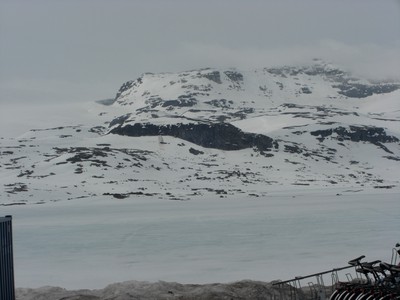




Järnvägen över fjället går upp på över 1300 meters höjd över havet. Den tog 12 år att bygga. Det var ett svenskt projekt från unionstiden, men det blev inte klart förrän 1907, efter unionsupplösningen. Man hade oerhörda svårigheter att bygga järnväg på så hög höjd. Vid ett tillfälle dog chefsingenjören i en snöstorm. Och det är arbetsamt att hålla järnvägen ren från snö på vintern. Stora snöslungor håller spåren rena, och långa sträckor är överbyggda med träbyggnader för att slippa snön. Dessutom var det inte så länge sedan som spåren drogs om på den högst belagda sträckningen. Över 10 kilometer lades då i en tunnel, där man ju slipper snön. Man har också byggt om järnvägen närmast Bergen, där den tidigare låg i mycket skarpa kurvor. Nu har man helt enkelt byggt tunnlar genom bergen istället för att gå runt dem.
Tåget var bekvämt och trevligt. Jag hade sällskap med en rar äldre dam från Bergen, som gärna pratade om de skid- och vandringsturer hon hade gjort på fjället, vid snart sagt varje station.

Tåget väntar på Bergens station på morgonen. Jag åkte i det silverfärgade tåget.

Den första sträckan gick banan mest utefter en mycket vacker fjord.













Myrdals station, där sidospåret till Flåm finns. En ganska kort järnväg går ned från över 600 meters höjd nästan till havets nivå vid Flåm vid Sognefjorden. Flåmsbanen är den järnväg i världen som har störst lutning (5.5 procent; högsta tillåtna på svenska stambanor är 1 procent) och drivs utan hjälp av kuggräler och liknande.


Utsikt ned i Flåmsdalen.

Tyvärr störs denna bilden av en ledningsstolpe som kom med. Straxt till höger om den ser man dock Flåmsbanan komma ut ur en av tunnlarna.

Här kan man tydligt se en av de stora cirklar som Flåmsbanen går i för att inte var ännu brantare.


På andra sidan strömmen skymtar den väg som rallarna byggde för att kunna frakta fram material till banbygget. Den är nu omgjord till vandrings- och cykelled.



Finse är den högst belägna stationen. Här föll 1913 under ett dygn 8 meter snö!





